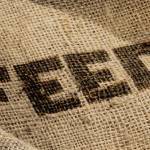Horse Feed Ingredients: Lupins

Lupins are leguminous seeds, similar to peas or beans, often used in horse feeds, especially in Australia. Sometimes called lupin beans, two major varieties exist, the bitter and the sweet. Only sweet lupins are suitable for horse consumption. When crushed, sweet lupins have yellow flesh and may be mistaken for corn in a mixed feed. They are easily discernible by their speckled seedcase.
“Lupins are used predominantly as a source of protein (28-34% crude protein) in horse feeds, but they also contain some fat (around 5%) and digestible fiber. Because they have less lysine and methionine than other protein sources such as soybean meal, more lupins would be required to supply the same amount of essential amino acids,” said Peter Huntington, B.V.Sc., M.A.C.V.Sc., director of nutrition at Kentucky Equine Research (KER) Australia.
Lupins are more palatable than soybean meal, and because they are a grain rather than a meal, it is easier to feed larger amounts. “Lupins can be fed at up to 4.5 lb (2 kg)/day for a 1,100-lb (500-kg) horse,” advised Huntington.
In addition to their protein content, lupins are a sensible energy source and can provide up to 25% of the total grain mix for a performance horse. They are low in starch, but high in digestible fiber. Because of their low starch and high fiber content, lupins are digested efficiently in the hindgut of the horse through fermentation. Similar high-fiber feeds used in other areas of the world include beet pulp and soy hulls, although these do not have the high protein or fat content of lupins and are therefore not as energy-dense.
Lupins should not be the sole concentrate component of a diet but can be used strategically as a supplement.
Protein supplement. As a protein supplement, lupins can be quite cost-effective and are usually considered good value compared to other commercial or synthetic protein supplements. They contain minimal indigestible fiber, such as lignin.
Super-fiber quality. The most commonly fed super fibers are beet pulp, soy hulls, and lupin hulls. These feeds are more digestible than traditional fiber sources. For instance, hay is 40-60% digestible, depending on its quality, and beet pulp and soy hulls are 80% and 75% digestible, respectively.
“Lupins are becoming a popular ingredient in Australian rations, largely due to their highly digestible fiber content. Other advantages of lupins include exceptional palatability and low cost,” said Huntington.
Many performance horses benefit from super fibers, especially those asked to perform at moderate speeds for long distances such as endurance horses. In addition to being a steady energy source for horses, super fibers help maintain intestinal health. Consumption of fiber increases water intake, creating a holding tank of water and electrolytes in the hindgut. This reservoir helps prevent dehydration and electrolyte depletion during an exercise bout.
Horses that do not tolerate diets high in starch may also benefit from super fibers like lupin hulls. Horses afflicted with recurrent exertional rhabdomyolysis (RER) or equine polysaccharide storage myopathy(EPSM) often find relief when fed diets low in starch, according to Huntington. When super fibers are fed to these horses, much of the energy necessary to support exercise is derived from fiber, not starch.








